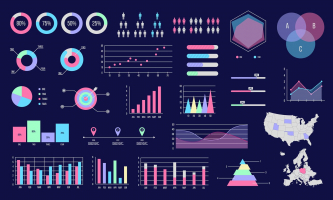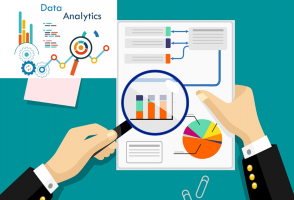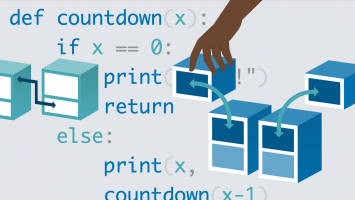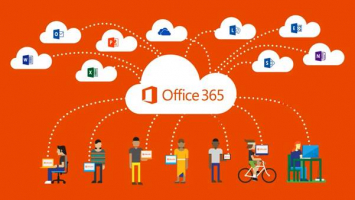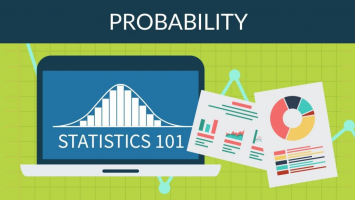Top 9 Best Online Data Manipulation Courses
Are you wondering which remote classroom to attend? You have spare time and want to broaden your horizon about a specific field of study whilst just staying at ... read more...home. Thus, to satisfy the burgeoning demand for online yet qualifying courses, Toplist has complied a rundown of the Best Online Data Manipulation Courses offered by the famous companies, top organizations and knowledgeable instructors across the globe for who in need!!!
-
Positioning the first on the list of Best Online Data Manipulation Courses, Data Manipulation in RPA offered by UiPath is definitely worth mentioning. Variables, Arguments, and Data Manipulation will all be covered in the RPA Data Manipulation course. It will also cover the types of variables and arguments, as well as how to use them in automation applications.
In the second half of the course, you'll learn how to manipulate data in Studio. You'll also learn about the many techniques and operations that can be performed on various data types, as well as how to apply them to automation applications. Demonstration videos will be used to teach the operations and procedures based on each concept. Multiple practice tasks are included in the course to help you develop your knowledge and understand how to create workflows in Studio.This course offers:
- Flexible deadlines: Set and maintain flexible deadlines.
- Certificate : Earn a Certificate upon completion
- 100% online
- Beginner Level
- Approx. 8 hours to complete
- Subtitles: English
- Course 2 of 6 in the Robotic Process Automation (RPA) Specialization
Coursera Rating: 4.9/5
Enroll here:https://www.coursera.org/learn/data-manipulation-in-rpa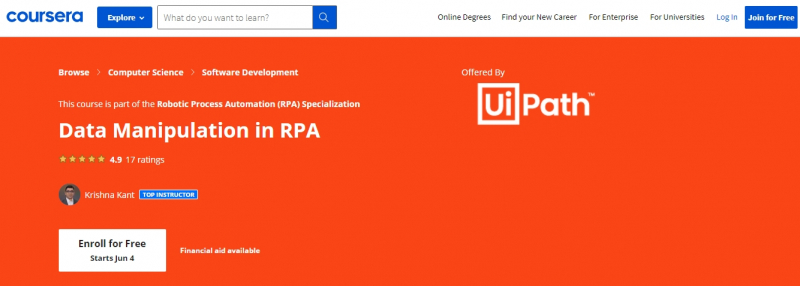
https://www.coursera.org 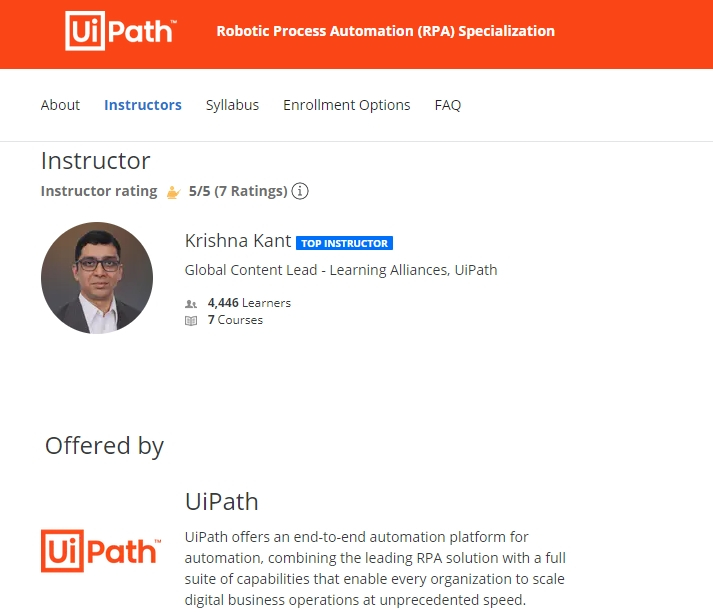
https://www.coursera.org - Flexible deadlines: Set and maintain flexible deadlines.
-
Welcome to Data Manipulation with dplyr in R, Data Manipulation with dplyr in R offered by Coursera Project Network is a project-based course. This project will teach you how to use the dplyr package in R to manipulate data.
By the end of this 2-hour project, you'll know how to modify the gapminder dataset using dplyr verbs like select, filter, arrange, mutate, summarize, and group by. You'll also learn how to manipulate the gapminder dataset using a combination of dplyr verbs to achieve the desired result.
To complete this guided assignment, you do not need to be an expert data analyst, data scientist, or statistical analyst; only knowledge with the R language is required. If you haven't used R before,maybe you should start with the Getting Started with R project before moving on to this one.
This course offers:- Flexible Schedule: Set and maintain flexible deadlines.
- Certificate : Earn a Certificate upon completion
- 100% online
- Beginner Level
- Approx. 2 hours
- Subtitles: English
Coursera Rating: 4.5/5
Enroll here: https://www.coursera.org/projects/data-manipulation-with-dplyr-in-r
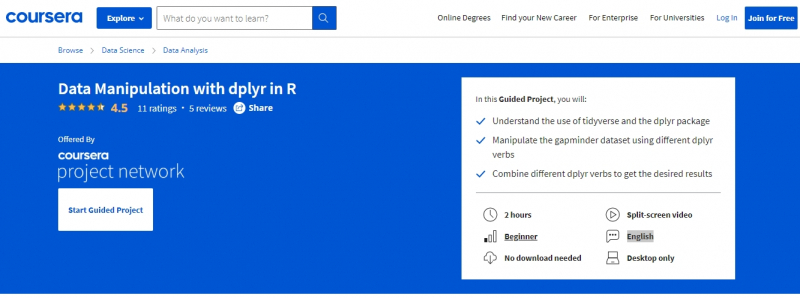
https://www.coursera.org 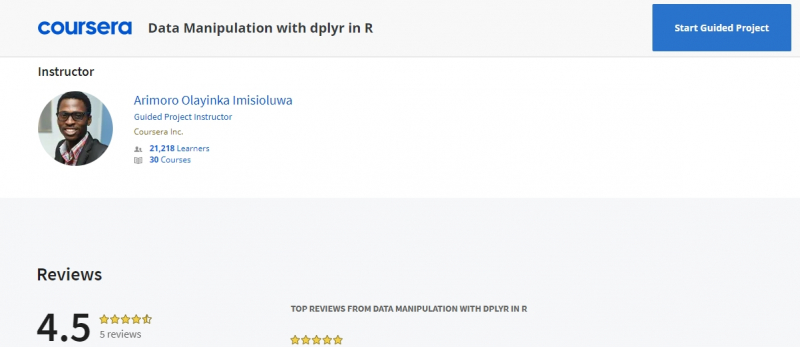
https://www.coursera.org - Flexible Schedule: Set and maintain flexible deadlines.
-
Data Manipulation at Scale: Systems and Algorithms offered by University of Washington is among the Best Online Data Manipulation Courses. People are drowning in data analysis, which has supplanted data acquisition as the bottleneck to evidence-based decision making. Extraction of knowledge from vast, heterogeneous, and noisy datasets necessitates not only powerful computer resources, but also the programming abstractions necessary to make them work. In the recent decade, abstractions have arisen that combine ideas from parallel databases, distributed systems, and programming languages to build a new class of scalable data analytics platforms that serve as the foundation for data science at realistic sizes.
The landscape of relevant systems, the principles on which they rely, their tradeoffs, and how to evaluate their value against your objectives will all be covered in this course. You'll learn how real systems were created from cutting-edge computer science research, as well as what systems are in the horizon. Cloud computing, SQL and NoSQL databases, MapReduce and the ecosystem it generated, Spark and its contemporaries, and graph and array specialist systems will all be explored.
You'll also learn about data science's history and background, as well as the skills, difficulties, and approaches that the word implies, as well as how to structure a data science project.This course offers:
- Flexible deadlines: Set and maintain flexible deadlines.
- Certificate : Earn a Certificate upon completion
- 100% online
- Beginner Level
- Approx. 20 hours to complete
- Subtitles: Arabic, French, Portuguese (European), Italian, Vietnamese, German, Russian, English, Spanish
- Course 1 of 4 in the Data Science at Scale Specialization
Coursera Rating: 4.3/5
Enroll here: https://www.coursera.org/learn/data-manipulation
https://www.coursera.org 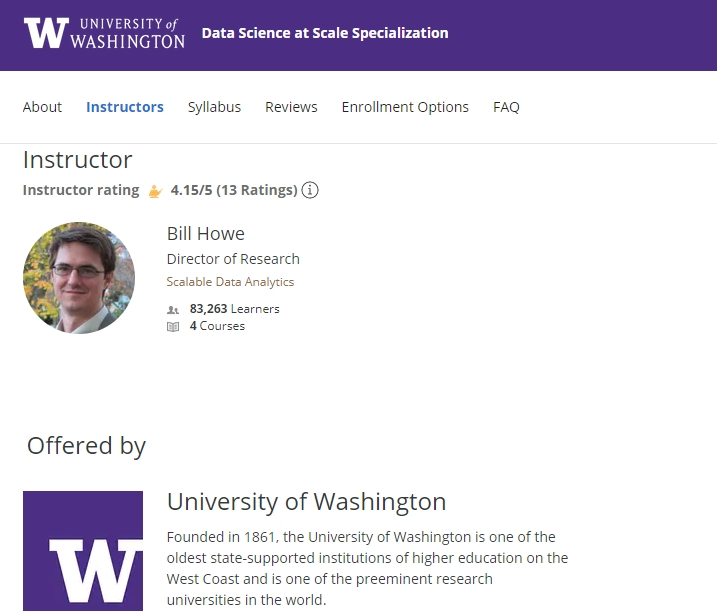
https://www.coursera.org - Flexible deadlines: Set and maintain flexible deadlines.
-
As one of the Best Online Data Manipulation Courses, Data Manipulation in JavaScript offered by University of California, Davis builds on the abilities learned in the prior course by delving deeper into data management and manipulation using JavaScript. You'll learn how to validate and handle data that users supply or that comes from an external data source. This course features a seat reservation system challenge as well as a project that pulls data from an external data source.
Validation basics in JavaScript and jQuery; jQuery form validation plugin features; arrow functions; asynchronous functions; and the JavaScript event loop are among the course objectives.This course offers:
- Flexible deadlines: Reset deadlines in accordance to your schedule.
- Certificate : Earn a Certificate upon completion
- 100% online
- Beginner Level
- Approx. 19 hours to complete
- Subtitles: English
- Course 4 of 4 in the JavaScript for Beginners Specialization
Coursera Rating: 4.6/5
Enroll here: https://www.coursera.org/learn/javascript-data-manipulation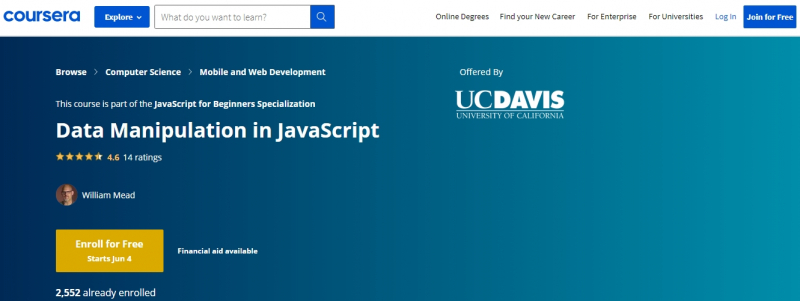
https://www.coursera.org/ 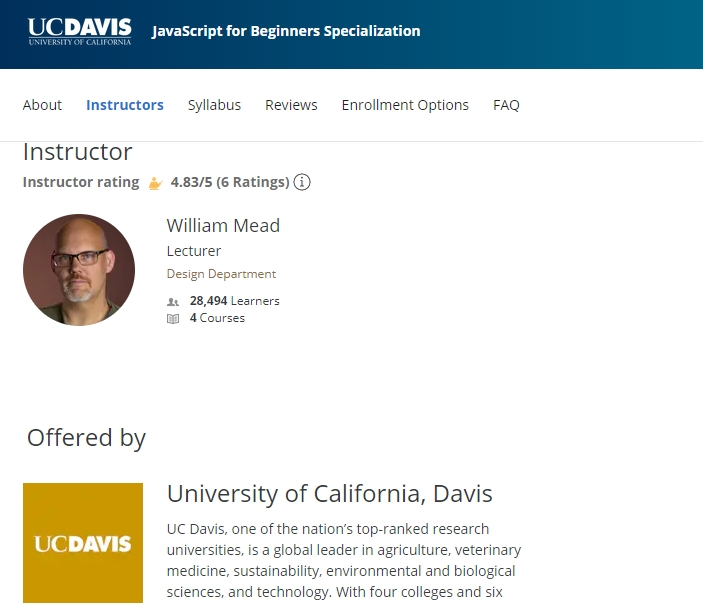
https://www.coursera.org/ - Flexible deadlines: Reset deadlines in accordance to your schedule.
-
You will learn how to write SQL code to modify data in a relational database table in this course. You'll start by entering data into the table. Because a database and its tables are designed to be data repositories, getting the data into the tables is a crucial step in creating a functional database.
When it comes to designing a new house, the real test comes when the furniture and family arrive. It's the same with database tables: once you've designed and built them, the real test begins when you load data into them and start using them.You'll become familiar with SQLiteStudio, the database management system utilized in the course, as you work through and complete hands-on assignments. You'll get a firsthand look at how data types and constraints affect table data manipulation. You'll appreciate the added protection offered by the main key constraint as you enter new data into a table, for example. It will not allow you to put two identical rows into a table.
You'll develop SQL code to edit existing data values and delete rows of data in addition to adding data to the tables. SQL's core functions are data management and manipulation, and SQL coding will be a valuable addition to your toolkit.- Note: This course works best for learners who are based in the North America region. We’re currently working on providing the same experience in other regions.
This course offers:
- Flexible Schedule: Set and maintain flexible deadlines.
- Certificate : Earn a Certificate upon completion
- 100% online
- Beginner Level
- Approx. 50 minutes
- Subtitles: English
Coursera Rating: 4.6/5
Enroll here: https://www.coursera.org/projects/manipulating-data-with-sql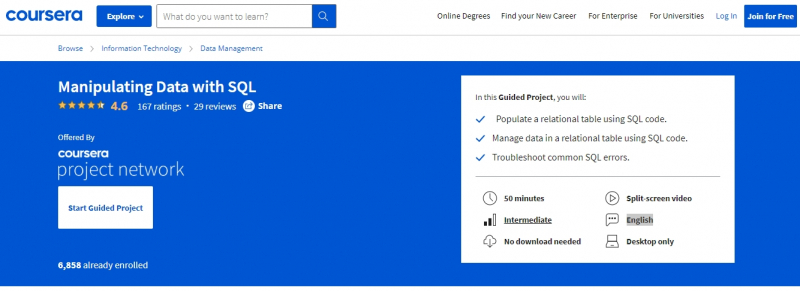
https://www.coursera.org/ 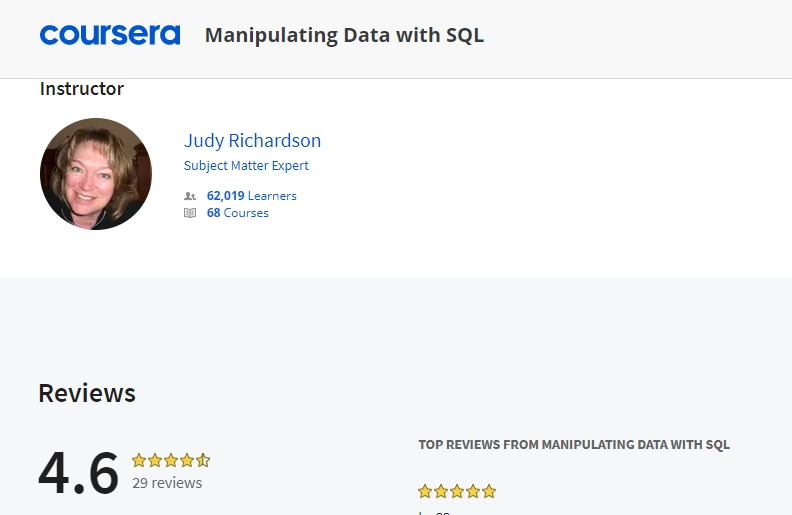
https://www.coursera.org/ - Note: This course works best for learners who are based in the North America region. We’re currently working on providing the same experience in other regions.
-
During this Performing Data Definition and Manipulation in SQL offered by Coursera Project Network, you will learn how to utilize SQL data definition statements for various data definition activities and SQL data manipulation statements for data manipulation tasks such as changing records in a table in this 2-hour project-based course. You'll also learn how to use PostgreSQL to upload a CSV file into a database.
In a video that plays in a split-screen with your work area, your instructor will walk you through these steps:
- Create a database to store database objects (tables)
- Data definition (Creating tables in the database)
- Data manipulation (Inserting data into the tables created)
- Upload a CSV file into the database
- Alter, rename and update records in a table
- Drop, truncate and delete records from a table
This course offers:
- Flexible Schedule: Set and maintain flexible deadlines.
- Certificate : Earn a Certificate upon completion
- 100% online
- Beginner Level
- Approx. 2 hours
- Subtitles: English
Coursera Rating: 4.6/5
Enroll here: https://www.coursera.org/projects/performing-data-definition-and-manipulation-in-sql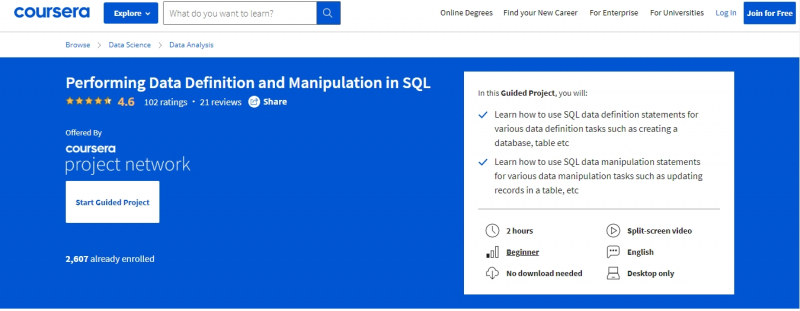
https://www.coursera.org 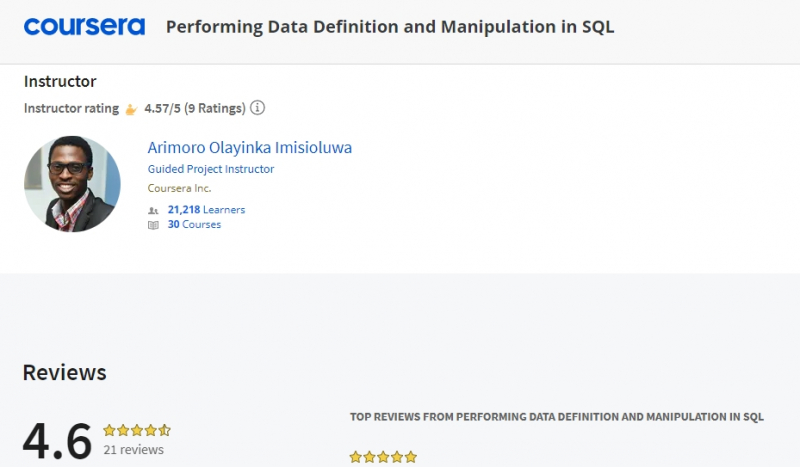
https://www.coursera.org -
Data Manipulation in Python: A Pandas Crash Course will help you to prepare to master advanced data manipulation, preparation, sorting, blending, and data cleaning techniques with Pandas DataFrame to transform chaotic bits of data into a finished pre-analysis output. Pandas is the most popular Python data science library, and Pandas is used by data scientists at Google, Facebook, JP Morgan, and practically every other large organization that analyzes data.
This course is for you if you want to learn how to use Pandas to manipulate, transform, pivot, stack, combine, and aggregate data in preparation for visualization, statistical analysis, or machine learning. Finally, this course includes a cheatsheet as well as practical tasks based on real-life scenarios. So you'll not only learn the theory, but you'll also gain some practical experience with Pandas.Requirements:
- Basic knowledge of Python
Who this course is for:
- Python students that want to learn how to manipulate data professionally.
- Aspiring data analysts and scientists looking to upgrade their skillset.
- People who would prefer to spend more time solving interesting problems than formatting data.
- Old hands at programming that want to see what new methods and industry-leading tools are at their fingertips in the new decade.
Subtitles: English
Udemy Rating: 4.7/5.0
Enroll here: https://www.udemy.com/course/data-manipulation-in-python/
https://www.udemy.com 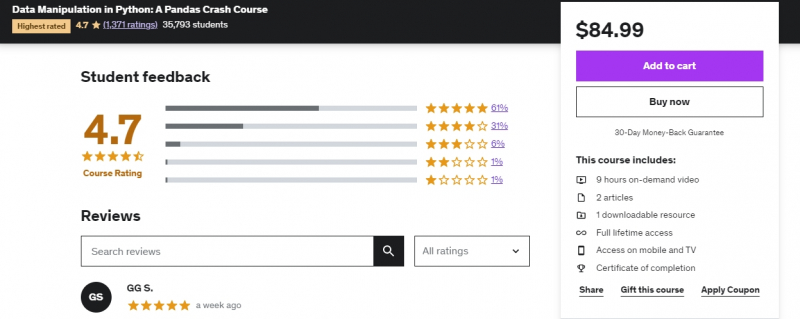
https://www.udemy.com -
When it comes to attractiveness, data scientists are already at the top of the list. It's difficult to maintain them after they've been hired in a highly competitive employment market. It's difficult to locate people with a unique combination of scientific training, computer expertise, and analytical skills.
Modern-day data scientists, like the Wall Street "quants" of the 1980s and 1990s, are expected to have a comparable skill set. People with physics and mathematics backgrounds attracted to investment banks and hedge funds in those days because they could devise new algorithms and data approaches.Data science, on the other hand, is quickly becoming one of the most well-suited professions for success in the twenty-first century. It is a computer-based, programming-driven, and analytical system. As a result, it's no surprise that the demand for data scientists has been expanding in the job market over the previous few years.
On the other hand, supply has been extremely limited. It is difficult to acquire the necessary information and skills to be hired as a data scientist. There are numerous online resources for learning Python. As a result, students are frequently intimidated by Python's steep learning curve.Requirements:
- No prior data science knowledge required
- No programming experience needed
Who this course is for:
- No previous skills or expertise required. Only a drive to succeed!
Subtitles: English
Udemy Rating: 4.3/5.0
Enroll here: https://www.udemy.com/course/master-data-science-in-python/
https://www.udemy.com 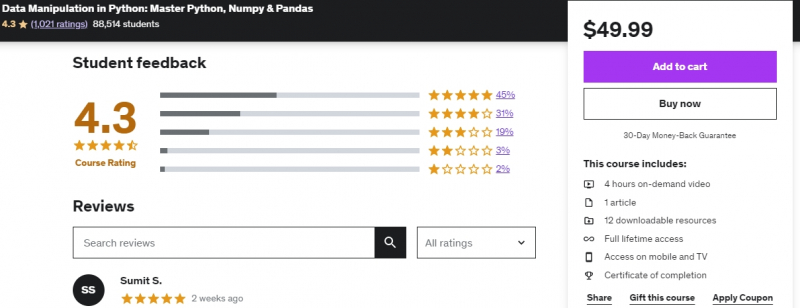
https://www.udemy.com -
Data manipulation is an important data analysis ability - in fact, it is the basis of data analysis. This course will teach you how to use dplyr, R's most powerful data manipulation tool.
As a data analyst, you'll be spending a lot of time preparing or processing data. Data preparation aims to transform your raw data into a high-quality data source that can be analyzed. The majority of the time, this procedure necessitates a significant amount of effort. The dplyr package includes the tools that can greatly simplify this task.Dplyr quickly became the most popular data manipulation tool among R data scientists as a result of these factors. You will be able to after completing this course to: It's a quick course, but it covers the most important commands and functions in the dplyr package, the ones you'll probably use the most.
Requirements:
- Basic R programming knowledge
Who this course is for:
- People who want to become R analysts
- Students and statisticians who want to learn R
- People who want to learn the fundamentals of data manipulation using R
Subtitles:English
Udemy Rating: 4.7/5.0
Enroll here: https://www.udemy.com/course/data-manipulation-with-dplyr-in-r/
https://www.udemy.com 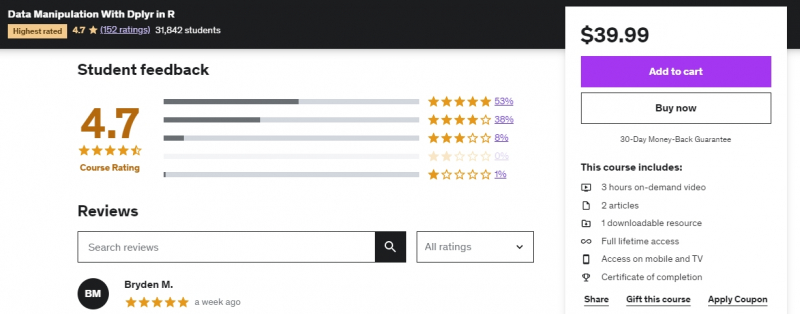
https://www.udemy.com












